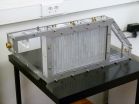(Press-News.org) Over one thousand miles wide and three thousand miles long, the Sargasso Sea occupies almost two thirds of the North Atlantic Ocean. Within the sea, circling ocean currents accumulate mats of Sargassum seaweed that shelter a surprising variety of fishes, snails, crabs, and other small animals. A recent paper by MBARI researcher Crissy Huffard and others shows that in 2011 and 2012 this animal community was much less diverse than it was in the early 1970s, when the last detailed studies were completed in this region.
This study was based on field research led by MBARI Senior Scientist Ken Smith, using the Lone Ranger, a 78-meter (255-foot) research vessel owned and operated by the Schmidt Ocean Institute. During three cruises in 2011 and 2012, Smith's team steamed across the Sargasso Sea and used dip nets to collect samples of Sargassum seaweed (and its associated animals) at six different locations. They then classified and counted all the animals at each site.
The researchers chose their sampling and counting methods carefully so that they could compare their results with previous surveys that had been conducted in 1972 and 1973 in the same general part of the Sargasso Sea. Amazingly, the researchers could find no other studies between 1973 and 2011 during which scientists had systematically counted the Sargassum animal communities in this area.
When the team analyzed the data from the recent cruises, they were surprised to find that animal communities in the Sargassum rafts were significantly less diverse than those observed in the 1970s. For example, 13 species of animals in several different groups (worms, nudibranchs, crustaceans, and sea spiders) were observed in the historical samples but were missing from the recent samples.
Unfortunately, the researchers did not have enough data to determine whether the differences they observed were the result of long-term shifts in ocean conditions in the Sargasso Sea or natural variations from place-to-place, month-to-month, or year-to-year.
The authors note that ocean conditions were much cooler than normal during February 2011 and that there were large differences in animal communities observed just six months apart, in August 2011 and February 2012. So it is possible that this area routinely sees large natural variations in the types of animals present. As Huffard put it, "If this is a long-term decline [in biodiversity], then it is a very significant one. But we don't know if this is part of the natural variability in this community."
Previous studies indicate that much of the seaweed that ends up in the Sargasso Sea originates in the Gulf of Mexico and is carried into the central Atlantic by the Gulf Stream and other currents. This suggests that, in addition to local ocean conditions, large-scale variations in ocean currents and conditions in the Gulf of Mexico could affect the animals in Sargassum communities.
To tease out these confounding variables, Smith and Huffard are hoping to conduct a series of follow-up expeditions to the Sargasso Sea. They plan to focus on the northern part of the Sargasso Sea, near Bermuda, where more detailed historical data are available. They are presently working on a proposal for a grant that would allow them to analyze satellite imagery and collect field samples twice a year for three years. The proposed study would show how much year-to-year variability is normal for this region.
At first glance, the animals that live in Sargassum rafts seem isolated from the rest of the world. But, like the seaweed they live in, these animal communities have many links to larger ocean food webs. For example, Sargassum animals provide essential food for sea birds, sea turtles, and bluefin tuna—all long-distance migrators. In fact, Sargassum rafts have been designated as "essential fish habitat" by the South Atlantic Fishery Management Council.
The world's oceans are changing, with water temperatures and ocean acidity on the rise and oxygen concentrations on the decline. In the Sargasso Sea, as in many other locations, detecting the biological effects of these long-term trends is a formidable challenge because animal communities can vary dramatically over short time periods. This study shows that animal communities in the Sargasso Sea are definitely changing. The next step is to find out why.
INFORMATION:
Online version of release:
http://www.mbari.org/news/news_releases/2014/sargasso/sargasso-release.html
Big changes in the Sargasso Sea
2014-09-23
ELSE PRESS RELEASES FROM THIS DATE:
Study finds gallbladder surgery can wait
2014-09-23
LOS ANGELES – (September 23, 2014) –Laparoscopic cholecystectomy, a minimally invasive procedure to remove the gallbladder, is one of the most common abdominal surgeries in the U.S. Yet medical centers around the country vary in their approaches to the procedure with some moving patients quickly into surgery while others wait.
In a study published online Monday in the American Journal of Surgery, researchers found gallbladder removal surgery can wait until regular working hours rather than rushing the patients into the operating room at night.
"The urgency of removing ...
'Bendy' LEDs
2014-09-23
VIDEO:
This is an animation of the micro-rod growth process.
Click here for more information.
WASHINGTON D.C., Sept. 23, 2014 -- "Bendy" light-emitting diode (LED) displays and solar cells crafted with inorganic compound semiconductor micro-rods are moving one step closer to reality, thanks to graphene and the work of a team of researchers in Korea.
Currently, most flexible electronics and optoelectronics devices are fabricated using organic materials. But inorganic compound ...
Diabetes: Complexity lost
2014-09-23
WASHINGTON, D.C., September 23, 2014 -- For millions of people in the United States living with Type 1 or Type 2 diabetes, measuring the daily rise and fall of blood glucose (sugar) is a way of life.
Our body's energy is primarily governed by glucose in the blood, and blood sugar itself is exquisitely controlled by a complicated set of network interactions involving cells, tissues, organs and hormones that have evolved to keep the glucose on a relatively even keel, pumping it up when it falls too low or knocking it down when it goes too high. This natural dynamical balance ...
Future flexible electronics based on carbon nanotubes
2014-09-23
WASHINGTON, D.C., September 23, 2014—Researchers from the University of Texas at Austin and Northwestern University have demonstrated a new method to improve the reliability and performance of transistors and circuits based on carbon nanotubes (CNT), a semiconductor material that has long been considered by scientists as one of the most promising successors to silicon for smaller, faster and cheaper electronic devices. The result appears in a new paper published in the journal Applied Physics Letters, from AIP Publishing.
In the paper, researchers examined the effect ...
Lack of sleep increases risk of failure in school
2014-09-23
A new Swedish study shows that adolescents who suffer from sleep disturbance or habitual short sleep duration are less likely to succeed academically compared to those who enjoy a good night's sleep. The results have recently been published in the journal Sleep Medicine.
In a new study involving more than 20,000 adolescents aged between 12 and 19 from Uppsala County, researchers from Uppsala University demonstrate that reports of sleep disturbance and habitual short sleep duration (less than 7 hours per day) increased the risk of failure in school.
The study was led ...
Moving to the 'burbs is bad for business
2014-09-23
This news release is available in French. Montreal, September 23, 2014 — It's rare to see a Wal-Mart downtown. Big box stores usually set up shop in the suburbs, where rent is cheap and the consumer base is growing. So should smaller stores follow suit?
Not so fast, says Concordia University professor Tieshan Li. His recent study, published in the Canadian Journal of Administrative Sciences, shows that higher profits are had by retailers located furthest from where the market is expanding.
"Those results may seem counterintuitive but the decreased profits are ...
Los Alamos researchers uncover properties in nanocomposite oxide ceramics for reactor fuel
2014-09-23
Nanocomposite oxide ceramics have potential uses as ferroelectrics, fast ion conductors, and nuclear fuels and for storing nuclear waste, generating a great deal of scientific interest on the structure, properties, and applications of these blended materials.
"The interfaces separating the different crystalline regions determine the transport, electrical, and radiation properties of the material as a whole," said Pratik Dholabhai, principal Los Alamos National Laboratory researcher on the project. "It is in the chemical makeup of these interfaces where we can improve ...
Beating stress outdoors? Nature group walks may improve mental health
2014-09-23
ANN ARBOR, Mich. — They are common suggestions to remedy stress: You just need a breath of fresh air. Walk it off. Get out and see people.
Turns out all those things combined may in fact make you feel better – a lot better – a new large scale study suggests.
Group nature walks are linked with significantly lower depression, less perceived stress and enhanced mental health and well-being, according to the study conducted by the University of Michigan, with partners from De Montfort University, James Hutton Institute, and Edge Hill University in the United Kingdom. The ...
Paraffins to cut energy consumption in homes
2014-09-23
Thermal energy storage is a common strategy in energy production systems in which the period of production does not coincide with that of consumption. This happens with the production of hot water by means of solar thermal panels, for example; here, hot water is produced during sunlight hours when demand is lower. It is also the case in residential cogeneration, where heat and electrical power are simultaneously generated but not so demand. In both cases, storing the heat allows production to be decoupled from demand, thus making the integration of these technologies into ...
Advancing the understanding of an understudied food allergy disorder
2014-09-23
Investigators at Cincinnati Children's Hospital Medical Center have published the first study to extensively characterize eosinophilic gastritis (EG). The study, published in The Journal of Allergy and Clinical Immunology, found that EG is a systemic disorder that has high levels of eosinophils in the blood and gastrointestinal tract, involves a series of allergy-associated-immune mechanisms and has a gene expression pattern (transcriptome) that is distinct from that of a related disorder, eosinophilic esophagitis (EoE).
Eosinophilic gastrointestinal disorders are chronic ...






